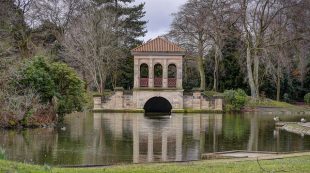The mob cheers as, in an empty grid square, a small park opens. Property prices in the area begin to rise; soon, a new demographic moves in. The recognisable shift towards gentrification. A familiar reality. And one that will soon be ruined by a rampaging prehistoric lizard.
SimCity and games like it allow us all to play god with simulated societies, building our own great places for living, or indeed destroying them with lizards or laser beams. The simulation in the original SimCity was incredibly crude, making the game’s designer, Will Wright, worried and sheepish at its adoption by town planning departments, as was recently recounted in an excellent blog post by Jimmy Maher:
If the interest SimCity prompted in the mainstream media wasn’t unusual enough, academia’s eagerness to jump on the bandwagon in these years long before “game studies” became an accepted area of interest is even more astonishing. Articles and anecdotes about Will Wright’s creation were almost as prevalent in the pages of psychology and urban-planning journals as they were in newspapers. Plenty of the papers in the latter journals, written though they were by professionals in their field who really should have known better, credited Wright’s experiment with an authority out of all proportion to the fairly simplistic reality of the simulation, in spite of candid admissions of its limitations from the people who knew the program best. “I wouldn’t want to predict a real city with it,” Wright said.
[...]And yet SimCity came to offer perhaps the most compelling demonstration of the Eliza Effect since Joseph Weizenbaum’s simple chatbot that had given the phenomenon its name. The world, SimCity proved once again, is full of Fox Mulders. We all want to believe.

Eliza is a computer program that mimics human responses to user-typed statements (you can try it out on the web here). Banal reactions peppered with complex-looking queries about information submitted by the user generates an illusion of sentience. In the same way, the original SimCity’s modelling of land value, crime, and pollution are fairly simplistic: industrial zones always pollute; zones distant from Police stations are always riddled with crime; parks push up desirability and subsequently land value. It looks as though it might be a realistic simulation, but often what we assess to be realistic is far from it: common sense can be wide of the mark when it comes to decision making that requires rational analysis.
Subsequent ‘god games’ have got better. They may still rely on approximations and averages, but are remarkable in their complexity, simulating layer upon layer of qualities and systems, interacting with each other to a greater or lesser degree. Mainly, the improvements have come about because advances in technology allow them. Desktop computers have been powerful enough for some time to allow integration of a number of large datasets into models, used for identifying risk and mitigation measures for flood, for instance. Now web technologies have advanced to the point where a number of complex open datasets can be incorporated into an econometric model that demonstrates the value of greenspaces.
ORVal, funded by Defra and developed by the LEEP institute at the University of Exeter is not a game but a tool, allowing users to estimate the number of visits to and recreational value of any publicly available ‘greenspace’ (a catch-all term; it includes parks but also beaches, which hopefully aren’t green) across England, from beaches to woodland, as well as examine the potential impact of creating new greenspaces. If the meaning of ‘natural capital’ has previously caused confusion, causing some to wrongly assume that amenity or ‘recreational value’ – as ORVal terms it − might be turned into cash value by a developer, ORVal allays these fears. A greenspace’s recreational value is greater where there are fewer greenspaces around; the tool, in fact calculates the value of a site by what would be lost if it did not exist and the public had to travel elsewhere. The tool doesn’t yet capture all the idiosyncracies of individual sites, but does allow features of the site to be tweaked to observe the effects of, for instance, planting more trees. It’s a great leap forward for a freely accessible tool that shows just how valuable greenspaces are to our economy.
An initial case study using the tool has examined the impact of the Millennium and Doorstep Greens, estimating a recreational benefit-to-cost ratio of 3.5, as well as providing valuable information about how these benefits are distributed between social groups. Such case studies, and examining the potential impacts of proposed greenspace projects, can help inform decisions both within and beyond government, and improve their cost-effectiveness.

Attendees at the launch of ORVal last month (6 September) saw considerable potential to use the tool in their scoping, appraisal and assessment work. Defra economists who worked on the tool received a lot of useful feedback, and are now working with the LEEP institute to improve the model further, such as providing more detailed information about the attributes of sites.
You can check it out (it's fun to play with) at leep.exeter.ac.uk/orval

Recent Comments